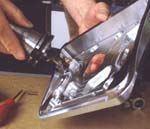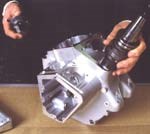Harley Davidson Parts Manufacturer Mills A 'Mile Of Aluminum'
This designer and manufacturer of Harley-Davidson aftermarket motorcycle engines and related components, is using PCD milling to finish engine cases, oil pumps, rocker boxes, inner and outer primary engine covers, and transmission cases and covers.
Share





Four years represents an eternity in the life of metalworking tools. In that time, TP Engineering (Bethel, Connecticut) has milled a mile of aluminum without changing the inserts on a Kennametal three-cartridge, 0-degree lead, 3-inch polycrystalline diamond (PCD)-tipped high-velocity face mill.
TP Engineering, a designer and manufacturer of Harley-Davidson aftermarket motorcycle engines and related components, is using PCD milling to finish engine cases, oil pumps, rocker boxes, inner and outer primary engine covers, and transmission cases and covers.
"We couldn't be happier with the performance of PCD milling," says Tom Pirone, TP Engineering's president and founder. "To this day, I find it amazing that we have never changed inserts."
In this application, TP is using PCD to work on 6061T6 aluminum and 356 aluminum, a difficult-to-machine material that it mills on a Mori-Seiki SH-400, a Mori-Seiki SH-403 and two Okuma MX 40 HA horizontal machining centers.
"The secret to the PCD face mill is in the design," says Gerry Dobrynski, the Kennametal field sales representative who services the TP Engineering account. "These lightweight but sturdy milling cutter bodies are engineered to best utilize the cutting power of the PCD adjustable cartridges that are secured to the cutter body with socket-head cap screws. Each cartridge is tipped with super-hard PCD (KD100 grade) that enables faster speeds, excellent tool life and superior surface finishes when compared to carbide or high speed steel (HSS) tools."
TP Engineering's use of PCD high-velocity face mills is enabling the company to mill 10,000 sfm at 140 ipm.
Besides increased tool life and decreased cycle time on the engine case from 1 hour to 24 minutes, Mr. Pirone is also pleased with the mirror finish that results from a Kennametal PCD face mill. "The surfaces achieve a superior finish with a phenomenal consistency that I didn't expect when I began using PCD, and I'm sure that it influences Harley-Davidson owners to buy our products."
TP Engineering replaced a carbide end mill 6 years ago with helical and router style Kennametal NGE-I end mills. The mills use six KC725M inserts for milling steel and six KC510M inserts to mill aluminum on a Mori-Seiki SH-400 horizontal machining center to perform profile milling on connecting rods, engine cases, inner and outer primary engine covers, oil pumps and rocker boxes.
The significant values for TP Engineering's use of an NGE-I end mill are 10,000 sfm at 120 ipm for milling aluminum and 500 sfm at 20-40 ipm for milling steel. By using NGE-I, TP has tripled productivity and tool life while improving the smoothness of surface finishes by a factor of three.
"TP Engineering has realized those quantitative and qualitative improvements because the NGE-I offers positive chip forming geometry, which results in free cutting action and lower cutting forces," says Brian Hoefler, Kennametal's NGE product manager.
"NGE end mills are versatile and can be used for machining shoulders, slots, contours and facing," Mr. Hoefler continues. "These features, combined with the latest Kennametal ‘M' milling grades, give users productivity advantages that are crucial to the milling requirements of many jobs that require the production of high-quality parts in record time."
Adds Mr. Pirone, "By getting 40 parts per insert edge instead of 12 or 13, having each insert cost us $12 a piece instead of $60 and having such responsive customer application and field service support, Kennametal provides the kind of value we wish all of our suppliers could give us."
Mr. Pirone has also integrated Kennametal drilling tools with his company's manufacturing operations. For the past 2 years, TP Engineering has been using KSEM Sculptured Edge High Performance modular drills on an Okuma MX-40 HA horizontal machining center to drill deep holes in rocker arms made of 4140 steel that has been heat treated, machined and then hardened to 32-36 HRC.
Using a drill body that is 5 inches long and a carbide blade in grade KC7215, TP is making 400 holes per blade that are 3.600 inches deep with a diameter of 0.630 inch.
"Because KSEM's design propels the drill into the workpiece at a tremendous penetration rate, while breaking chips effectively and maintaining stability, the user is ensured of getting precise, close-tolerance holes faster," says Kennametal's Mr. Dobrynski.
To make holes in the aluminum casting of the engine crankcase, TP is using a 5-inch drill body and a grade KC7235 blade to drill more than 2,000 holes (and counting) at a depth of 2.01 inches with a diameter of 1.125 inches. Kennametal performs factory reconditioning of the blades.
TP Engineering's use of Kennametal's holemaking know-how extends to the Dynapoint Triple-Flute (TF), a solid carbide drill that TP is using to make small-diameter holes in engine and transmission cases made of 356 and 6061 aluminum. With Dynapoint, TP Engineering is making 24,800 holes per body at 0.51 second per hole. A tool that TP formerly used had an output of only 1,000 holes per drill body at 4 seconds per hole.
With three flutes, the sculptured edge drill point creates a smooth transition from the major cutting edge to the center of the drill, eliminating stress peaks and allowing the drill to actively cut metal over the entire cutting edge.
Compared to conventional drills, which are ground with flat chisel points that will push and tear the metal, the sculptured edge design is said to allow the user to handle increased chip loads for faster penetration rates and greater productivity.
Over the past 4 years, Kennametal has helped TP Engineering reduce its cost per part, decrease cycle times and increase tool life.
Related Content
How to Meet Aerospace’s Material Challenges and More at IMTS
Succeeding in aerospace manufacturing requires high-performing processes paired with high-performance machine tools. IMTS can help you find both.
Read MoreMachine Monitoring Boosts Aerospace Manufacturer's Utilization
Once it had a bird’s eye view of various data points across its shops, this aerospace manufacturer raised its utilization by 27% in nine months.
Read MoreArch Cutting Tools Acquires Custom Carbide Cutter Inc.
The acquisition adds Custom Carbide Cutter’s experience with specialty carbide micro tools and high-performance burrs to Arch Cutting Tool’s portfolio.
Read MoreGrob Systems Inc. to Host Tech Event With Industry Partners
The 5-Axis Live technology event will highlight new machining strategies for optimizing the production of complex medical, aerospace and mold/die parts.
Read MoreRead Next
Registration Now Open for the Precision Machining Technology Show (PMTS) 2025
The precision machining industry’s premier event returns to Cleveland, OH, April 1-3.
Read MoreBuilding Out a Foundation for Student Machinists
Autodesk and Haas have teamed up to produce an introductory course for students that covers the basics of CAD, CAM and CNC while providing them with a portfolio part.
Read More5 Rules of Thumb for Buying CNC Machine Tools
Use these tips to carefully plan your machine tool purchases and to avoid regretting your decision later.
Read More

















.jpg;maxWidth=300;quality=90)

















